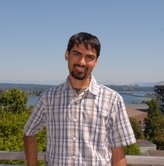Enabling Practical Ubiquity
 Shwetak Patel, University of Washington CS
Shwetak Patel, University of Washington CS
shwetakSeminar on People, Computers,
and Design
Stanford University November 20, 2009, 12:50pm, Gates B01
The use of sensing systems in the home has the potential to impact various application areas such as chronic care management, aging in place, and sustainability. However, a major challenge remains in identifying and developing truly ubiquitous sensing solutions that address deployment challenges of cost-effectiveness, installation, maintenance, and overall acceptability for a general audience. In the home, the goal of practical ubiquity has led me to develop a new sensing approach, which I call "Infrastructure Mediated Sensing," or IMS. Infrastructure mediation refers to the simple augmentation and probing of existing home infrastructure, such as the electrical power lines, plumbing, or HVAC systems, to sense human activity. In this talk, I will discuss my work in infrastructure and wireless sensing, applications of these technologies for demand side energy monitoring, and some new research directions.
![]()
Shwetak N. Patel is an Assistant Professor in the departments of Computer Science and Engineering and Electrical Engineering at the University of Washington. Dr. Patel is also a member of dub. His research interests are in the areas of Human-Computer Interaction, Ubiquitous Computing, and User Interface Software and Technology. He is particularly interested in developing easy-to-deploy sensing technologies and approaches for location and activity recognition applications. Shwetak is also the co-founder of Unsenso, Inc., a demand side energy monitoring solutions provider. Shwetak received his Ph.D. in Computer Science from the Georgia Institute of Technology in 2008 and B.S. in Computer Science in 2003. He was also the Assistant Director of the Aware Home Research Initiative at Georgia Tech. Dr. Patel was recently a TR-35 award recipient for 2009.
![]()
The talks are open to the public. They are in the Gates Building, Room B01 in the basement. The nearest public parking is in the structure at Campus Drive and Roth Way.
View this talk on line at CS547 on Stanford OnLine or using this video link.
Titles and abstracts for previous years are available by year and by speaker.